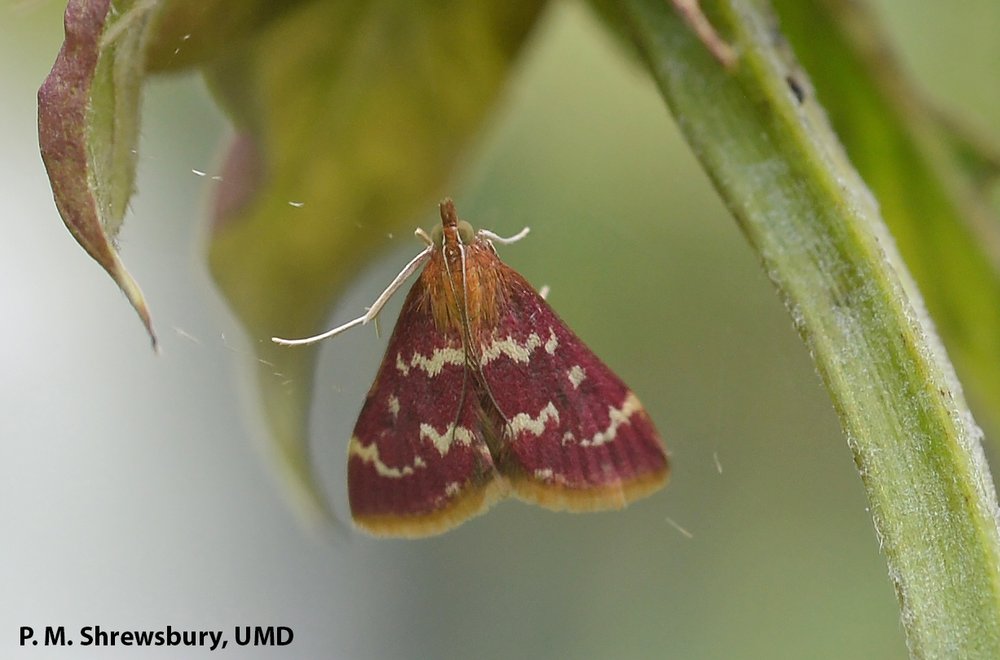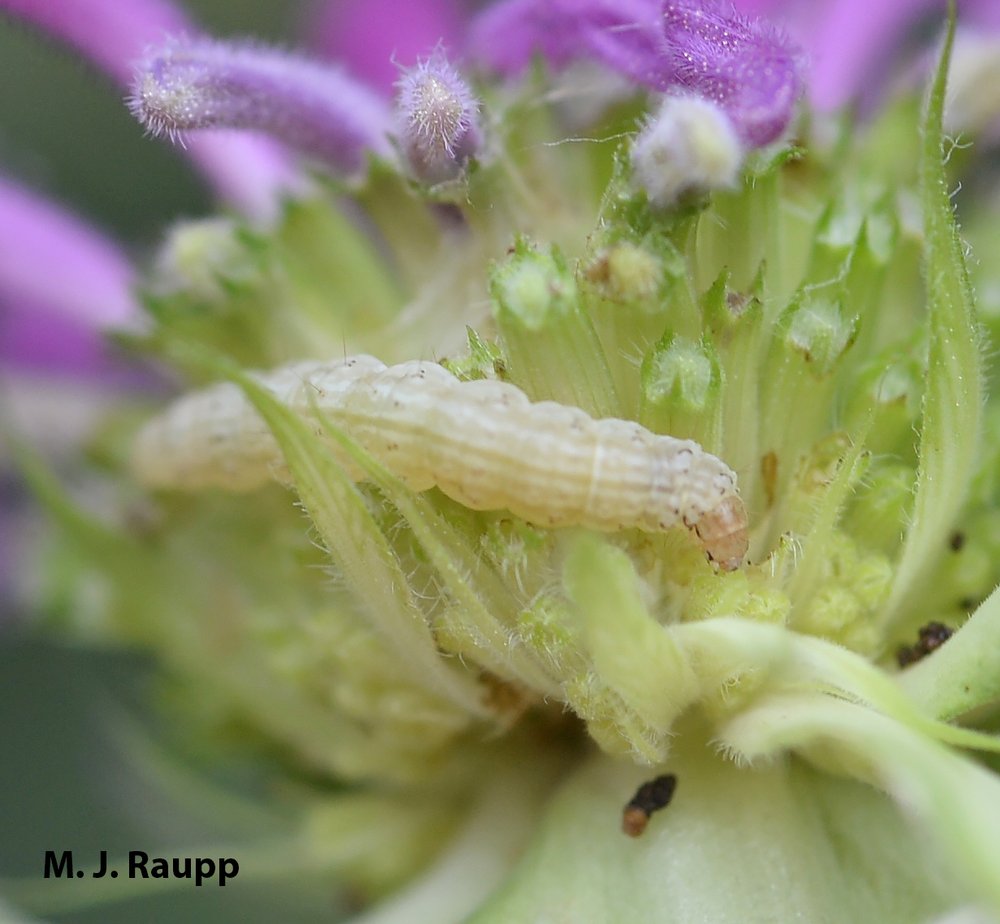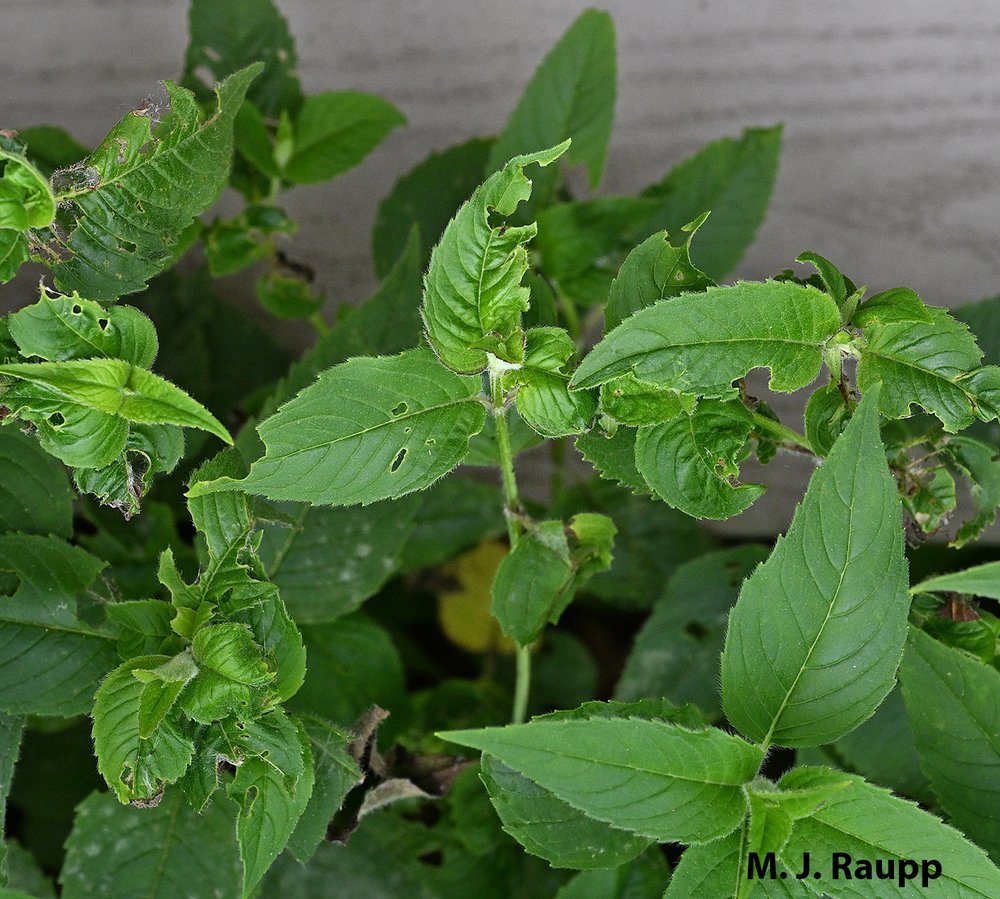
Eggs laid in buds of leaves and flowers by the pretty raspberry pyrausta moth hatch into hungry caterpillars ready to pillage monarda foliage and blossoms. Image: Paula Shrewsbury, PhD
After a few seasons of respite for my monardas, the raspberry pyrausta has returned with a vengeance to my perennial flower beds. For readers that love spotted beebalm, scarlet beebalm, and wild bergamot, this week we visit a pesky small caterpillar and learn some ways to help safeguard the blossoms of these wonderful perennial plants.

A small creamy colored caterpillar is the marauder feasting on my flowers.
Why should we protect the blossoms of monardas? By providing rich nectar rewards, these delightful natives are magnets for an astounding array of beneficial animals ranging from hummingbirds and gold finches to butterflies, bumble bees, hover flies, and myriad predatory and parasitic wasps. I have watched the summer parade of interesting and beautiful insects visiting monardas for hours over a cup of coffee on sunny summer mornings. But every year, there is foul-play afoot in my flower beds. Sometime in the latter days of May and early days of June just as the bergamot was prepping to bloom, developing flower buds, attendant sepals, and supporting leaves became shredded and riddled with holes. Close examination of the buds revealed tiny black pellets lodged in the nooks and crannies of the flower heads. Now, to bug geeks, tiny black pellets usually are a sign of insect activity. Said pellets are actually the excrement, a.k.a. frass, of caterpillars feeding within the flower buds. Some further poking around the nascent blossoms revealed small creamy colored caterpillars hiding in the axils of sepals and at the bases of florets.
While identification of small caterpillars presents a challenge even to seasoned entomologists, identification of adult moths and butterflies is way easier. A more extensive search of the bergamot patch revealed a rather pretty raspberry pyrausta moth, a member of the crambid moth clan. Crambid moths, also known as snout moths, are named for the elongated mouthparts protruding from the front of their head. Many bore into the stems of grasses and other monocots and some, such as the European corn borer and sod webworm, are serious agricultural and lawn pests. Just one or a few of these caterpillars feeding within a developing flower bud are sufficient to all but ruin its floral display.
While some blossoms on my bergamot look fine many are ravaged. This culprit is a small caterpillar feeding in the flower head. Chewed florets, holes in leaves, silk and pellets of frass are telltale signs of the caterpillar. Regular inspections and crushing caterpillars when you find them will help keep your blossoms looking fine.

Early generations of the raspberry pyrausta defoliate leaves and distort developing terminal buds.
Here is the dilemma. For many herbivores in my landscape, the death sentence is commuted under a live-and-let-live policy with the belief that even pests will become food for other insects or birds higher in the food web. However, in the case of the raspberry pyrausta, lack of intervention translates into few or no blossoms on monardas and few or no resources for pollinators, predators, and parasitoids dependent on nectar and pollen for their activity and survival. So, in this case the caterpillars gotta go to make way for the beneficial insects. Ridding the blossoms of caterpillars is fairly easy to do. As flower heads begin to form in late spring and early summer watch out for holes in leaves, feeding damage to developing florets, and small black frass pellets accumulating in the axils of leaves and sepals. Carefully search the flower head and when you locate the caterpillar, simply crush it. If you don’t like touching insects, don a pair of rubber gloves and do the deed. Mechanical destruction of the pest is foolproof and works well in small patches. For larger patches, you could consider using an insecticide listed by the Organic Materials Review Institute (OMRI) for controlling caterpillars. These insecticides have been reviewed by scientists and approved for use in the production of organic food crops. Two of my favorites contain the active ingredient Bacillus thuringiensis kurstaki (Btk) or spinosad. Btk is derived from a common soil microbe and it works well on many species of caterpillars. If you grow milkweeds as a source of food for monarch caterpillars in your flower beds, take care not to spray Btk on your milkweed lest you poison any resident monarch larvae.
Some brands of spinosad will also carry the OMRI stamp of approval and they work well on caterpillars. Spinosad is also a product of a soil microbe. This molecule attacks the nervous system of insects. But be careful with spinosad, as it is highly toxic to bees. If other plants in your garden are in bloom or are about to bloom, avoid drift that might contact and harm charismatic pollinators. Use the same caution with monarda. The pyrausta will be present in the early formation of flower buds but as florets form and mature, avoid using spinosad as bloom time approaches and certainly when flowers are in bloom. Many snout moths have multiple generations and in my experience the raspberry pyrausta is no exception. I have crushed several crops of caterpillars in the flower buds and just the other day, a few more adult moths dared to flit around my flower bed. For a bug geek, watching the sunrise on a warm summer morning while sipping some coffee and squashing some caterpillars is not a bad way to start the day.
No comments:
Post a Comment